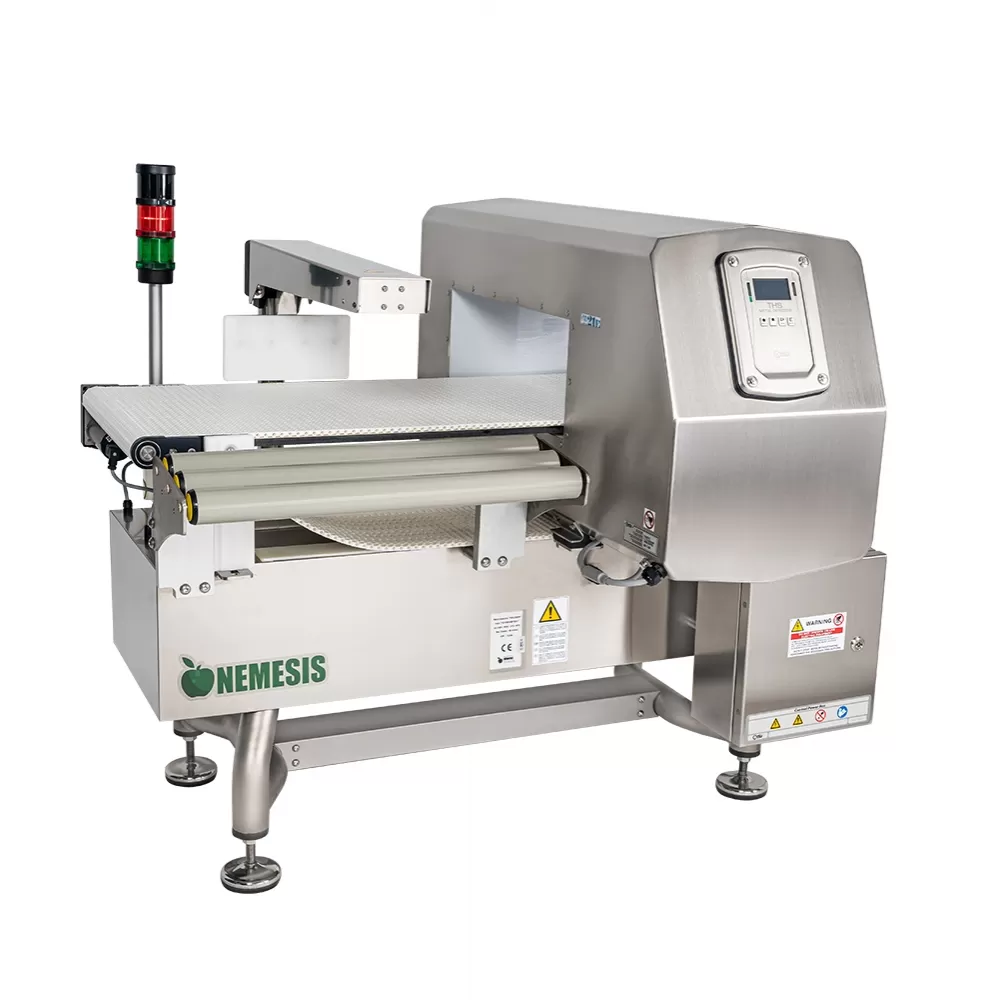
Metal detectors
M Series - Metal detector
The stand-alone metal detector
Metal detecting
Industrial metal detectors are used in production processes where regulations impose strict quality control for consumer safety, primarily in the food sector. Their function is to detect any contaminating particles in ferrous metal, non-ferrous metal (such as aluminum), and stainless steel.
This process is carried out in full compliance with the most stringent standards for food safety, such as HACCP, IFS, and BRC regulations.
Nemesis Metal Detectors can be:
In the case of stand-alone machines, the conveyor belt exiting the metal detector includes only one ejector to discard non-compliant products.
In the second case, the metal detector is installed on the input conveyor belt, and two ejectors are provided: one for products contaminated with metal and another for products non-compliant in weight.
The collection system must be separate because, by law, it is not possible to mix contaminated products with non-compliant ones. The contaminated product must be securely locked and properly disposed of by a designated operator, while the non-compliant product can be reintroduced into the production line.
How is a Metal Detector built?
Great attention must be paid to the materials used in the construction of a metal detector. For example, the conveyor belt must not contain metals that could affect detection.
How does a Metal Detector work?
Before putting a metal detector into operation, it needs to be familiarized with the product to be examined, so an Auto-Learning procedure is performed. This procedure involves letting the machine recognize a product considered free of contaminants by passing it through the machine two or three times. When a contaminated product is presented, the machine will immediately recognize it.
What does the Metal Detector detect?
As mentioned earlier, it can only detect metals such as ferrous, non-ferrous, and stainless steel. It does not detect glass, bones, etc., as X-rays are needed for these substances.
The sensitivity and performance of the machine depend on the size and composition of the product being analyzed.
The larger or heavier the product, the more challenging it is for the metal detector's magnetic field to analyze it accurately.
The reading becomes even more challenging if the product is composed of complex materials, meaning substances of different types. The sensitivity is measured based on the biggest minimum contaminant particle the metal detector can find for each type, measured in millimeters in diameter. Given the three families of contaminants, the measurements tend to be larger for stainless steel than for ferrous and non-ferrous metals.
Sensitivity cannot be considered an absolute value for the machine because it varies depending on the tested product. The detection becomes more difficult if the product contains aluminum packaging that already contains metal or if the product is wet (easier in a dry product like bread or rice cakes) or acidic (tomatoes or yogurt) or if its composition is complex (seafood salad) compared to more homogeneous and simpler products (salmon). The detection is also more challenging if the product already contains iron, as in the case of red meat or cheese. For this reason, metal detectors declare sensitivity only with an empty conveyor belt.
How is this data obtained?
A test product with a large contaminant tester is inserted, and it is ensured that the machine detects it. The operation is repeated by repeatedly lowering the weight of the contaminant tester and verifying each time that the machine continues to read it. When it no longer reads it, it means that the machine has reached the minimum, i.e., the smallest weight of contaminant it can detect.
Every metal detector is set to a frequency depending on its intended use.
During the Auto-Learning test, the machine tries all possible frequencies until it finds the best one for that product. It is an excellent solution for working with complex and different products each time.
The other important criterion to consider in choosing the model is the mouth opening of the metal detector, understood as width and height.
The best choice that maximizes the performance of the metal detector is one that allows one of the two sides of the mouth to be as close as possible to the product. In this way, the magnetic field is reduced and more focused on the product, making the machine more sensitive. In height, it is useful to remember that the conveyor belt inserted into the metal detector usually measures 30-35 mm in height, to which the product's height is added with a bit of tolerance considering its dimensional variability.
When it is necessary to integrate a metal detector into a checkweigher, it is necessary to choose the right model based on the machine's application. If the application is simple, a basic version will be sufficient. For more complex applications, it will be necessary to use a multispectrum version, capable of adapting to the product to be analyzed each time.
Related products
We'll be happy to follow-up your request within 24 hours